Interpretations of the Transatlantic Accent
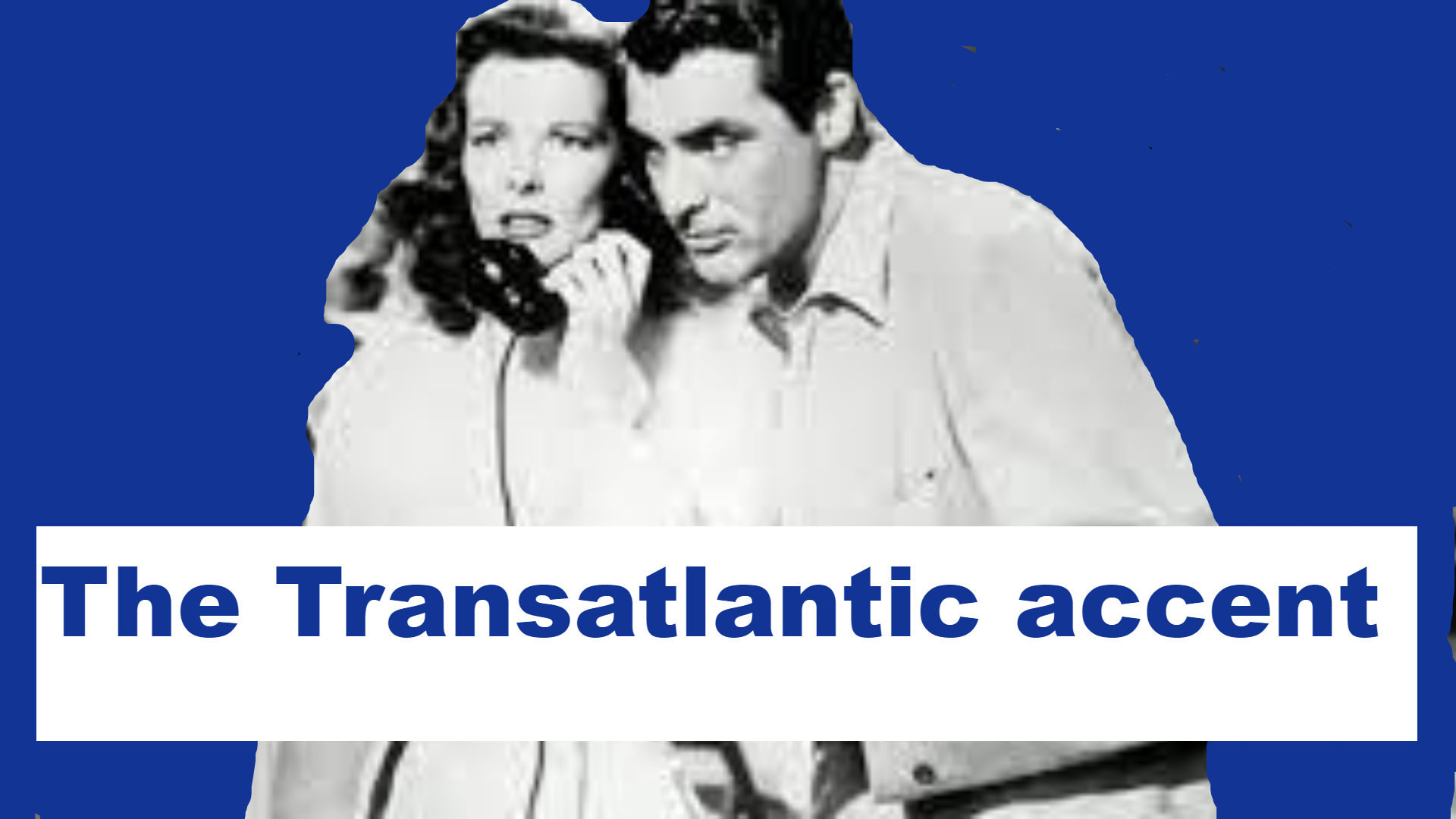
Introduction
We are all familiar with the posh, sophisticated sound of the early age of film. Speakers, donned in pearls and satin gowns, amidst a passionate speech, would somehow ooze their vowels, crunch their T’s, and completely drop their R’s. This is what we know as the transatlantic accent. Crafted in the early 20th century, this type of speech is known for the way it sought to find a balance between standard British English (BrE) and American English (AmE) dialects. It combines the feel of an American accent with the non-rhotic nature of the British accent to create a form of speech that is neutral in both status and region. As radio and film became more popular, a “voice culture” emerged where “more and more people became more and more aware of, and concerned with, the sound of spoken English” (Dawson 14), so this neutral way of speaking became quickly popular in media.
The accent became favored in film because it was taught in elocution lessons as the best, and only, way to speak properly. Edith Skinner originated the idea of “Good American Speech” with William Tilley in the 1940s. They worked to teach performers that “there is only one right way to speak and sound and every other way was bad or lesser” (Law 8). Though the accent is stereotypically neutral in its sound, Elliot notes the way that “speakers make use of varying rates of r-lessens in their role portrayals to mark status, express politeness to women, and reveal moral character” (122). While the accent faded out post-World War II as America deliberately focused on creating an American sound, “Good American Speech” is still taught at some acting institutions today. As an acting student, Law agrees that this standard is harmful as it teaches students that their own ways of speaking are somehow incorrect since “speech that was not ‘Good American Speech’ [was] an infection the world had to be rid of” (Law 8).
As acting students ourselves, we have both taken Voice & Speech for the Actor at Marymount Manhattan College, where the curriculum is shifting away from Skinner’s views. Instead, we are taught the negative impacts of past teachings and given the tools to embrace our natural ways of speaking for performance. With these lessons, we am able to look at the transatlantic critically and acknowledge how it is often “used as a marker of an ‘educated’ ‘cultivated’ or ‘cultured person’” even though no one has ever “spoke that way naturally” (Barrow). As supporters of this new curriculum, we wanted to see how the transatlantic accent is received today, and whether or not Voice & Speech training affects these reactions.
As such, we examine the stereotype of neutrality and ask the question, “What, if any, assumptions of status do audiences make from hearing the transatlantic accent in film, and does contemporary voice and speech training for actors influence these assumptions?” Although the accent was used to signal neutrality of region and status, we anticipate that when hearing the transatlantic accent, one will assume that the speaker is of high status, but there will be a high contrast in responses from those who have had Voice & Speech training and those who haven’t. Further, we expect those with Voice & Speech training will have more consistency and agreement in their assumptions since they are presumably viewing the material with an awareness of Skinner’s harmful practices.
Methodology of Data Collection
Informants
We surveyed eight current college students—four musical theatre majors who have taken Voice & Speech for the Actor at Marymount Manhattan College and four non-performance majors who have not. We chose college students as they are the marker of the next generation of media consumers. The transatlantic accent’s cultural value has declined over the past several decades (Elliot), so their impressions of it will be heavily influenced by the contemporary media they’ve consumed. Since our topic selection was influenced by our own Voice & Speech training at Marymount Manhattan College, we were interested in whether or not those who have taken Voice & Speech are more aware of the status implications that come from the accent. Actors who have taken this class are taught the ways that Skinner’s teaching was harmful and instead encouraged to find their own unique speech rather than manipulate a traditional sound to find success. Knowing performance majors would have this in mind, we wondered if their answers would differ at all from those who hadn’t been exposed to this training.
Method of Collection
We conducted our research through the online survey platform “Pollfish” since it allowed us to easily edit, review, and share our survey and results. The survey consisted of 56 questions broken into sections based on six audio clips. We used 30-40 second clips of audio from six films from the 1940s through 2010s. Each clip showed the voice of one character. We omitted any character detail or mention of crucial plot so that the listener ideally would not be influenced by context. Four of the characters used the transatlantic accent, one used a standard British accent, and one used a standard American accent. We included the latter two as controls to provide two extremes of the transatlantic sound’s influences as well as distract listeners from the fact that they were listening to transatlantic accents.
The six audios were presented to informants in the following order:
1) Effie Trinket (The Hunger Games Trilogy, 2010s)—Transatlantic English
2) Rey (Star Wars, 2010s)—British English
3) Tracy Lord (A Philadelphia Story, 1940)—Transatlantic English
4) Madison Montgomery—(American Horror Story: Coven, 2013)—American English 5) James Patrick March—(American Horror Story: Hotel, 2015)—Transatlantic English 6) Queen Amidala (Star Wars, 1999)—Transatlantic English
The order was randomly determined, though we did make sure to have the American and British controls mixed in the middle. We chose characters with transatlantic accents based on our own previous knowledge of films with that style of speech, though we also wanted to ensure there was a variety of moral status and character type. For the American and British controls, we chose from two catalogs that were already represented to present something with similar stylistic context but presumably different affect on our informants.
After each clip, participants answered the following questions:
1) Do you know who the character is and what film it is from? [Write in]
2) What do you think this person’s socioeconomic status is? [Upper Class/Middle Class/Lower Class]
3) What do you think their occupation might be? [Write in]
4) Is this person the protagonist or antagonist? [Protagonist/Antagonist]
5) Based on the audio, do you think this person has a strong sense of morality? [Yes/No] 6) Do you think this person wants or desires power? [Yes/No]
7) Where in the Unites States do you think this character is from? [Write in]
8) When do you think this film was made? [Pre 1920/ 1920-1940/ 1940-1960/ 1960-1980/ 1980-2000/ 2000-Present Day]
The first question was to confirm whether or not the informant was influenced by their previous knowledge of the character in answering the next few questions. If they answered yes, we acknowledged their bias in answering and did our best to work around their answers in our data. The rest sought to determine how the transatlantic accent is perceived in terms of socioeconomic status and moral status, as well as location and era. Since the accent was conceived to mediate between the UK and US in the 20th century, we wondered if listeners associated the sound with any particular region or time period.
At the end we asked each participant:
1) What is your major? [Write in]
2) Have you taken Voice and Speech [Yes/No]
This allowed us to differentiate responses by those who took Voice & Speech and those who didn’t as we had an equal amount of participants who had and hadn’t taken the class.
Reporting of Data
Once we received completed surveys from all of our informants, we sorted our data by audio and respondent in order to isolate responses. We looked at which informants took Voice & Speech and which didn’t and separated that data. We choose to highlight the questions regarding protagonist qualities, morality, and power as character traits that can be highlighted by language.
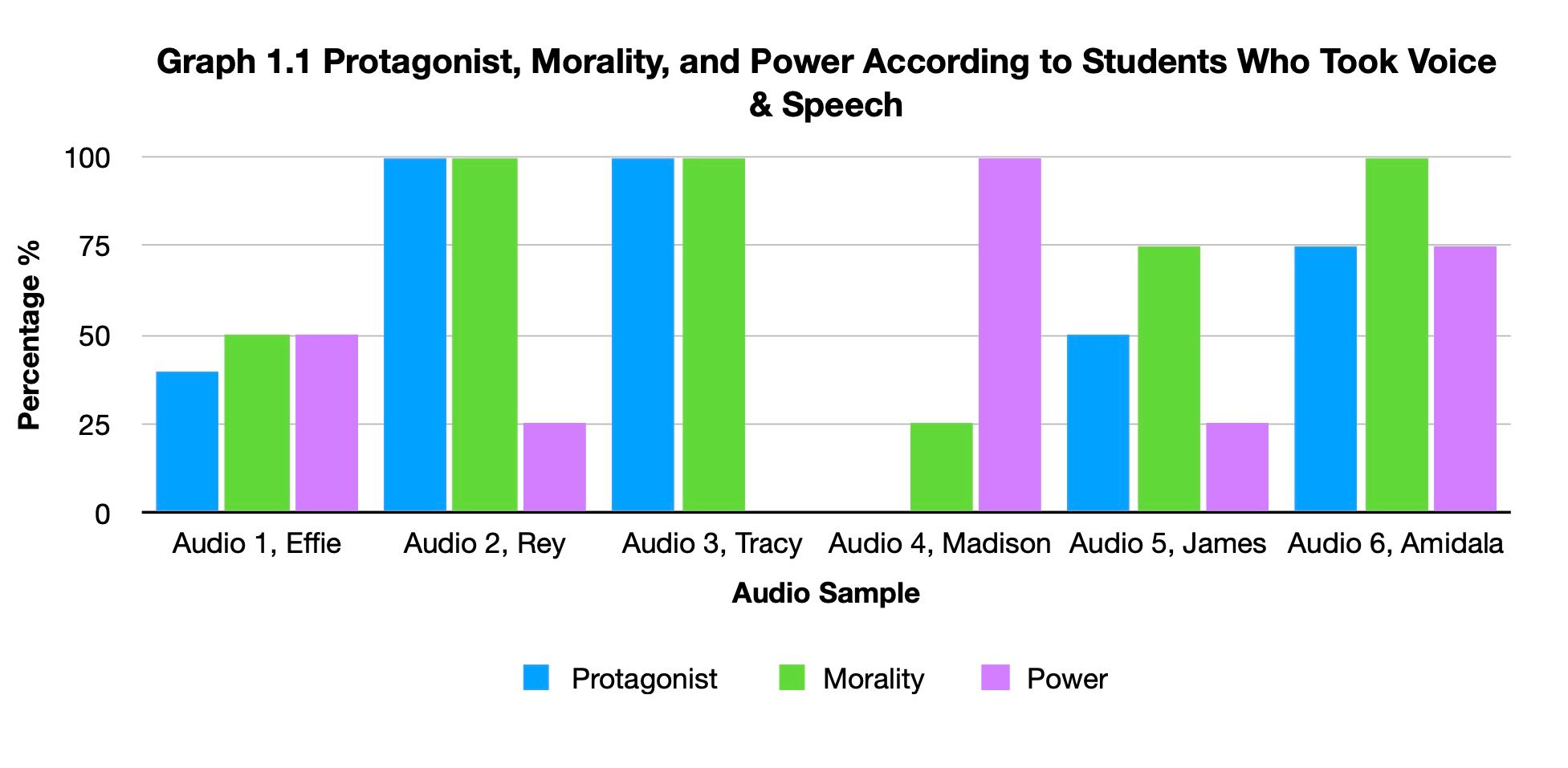
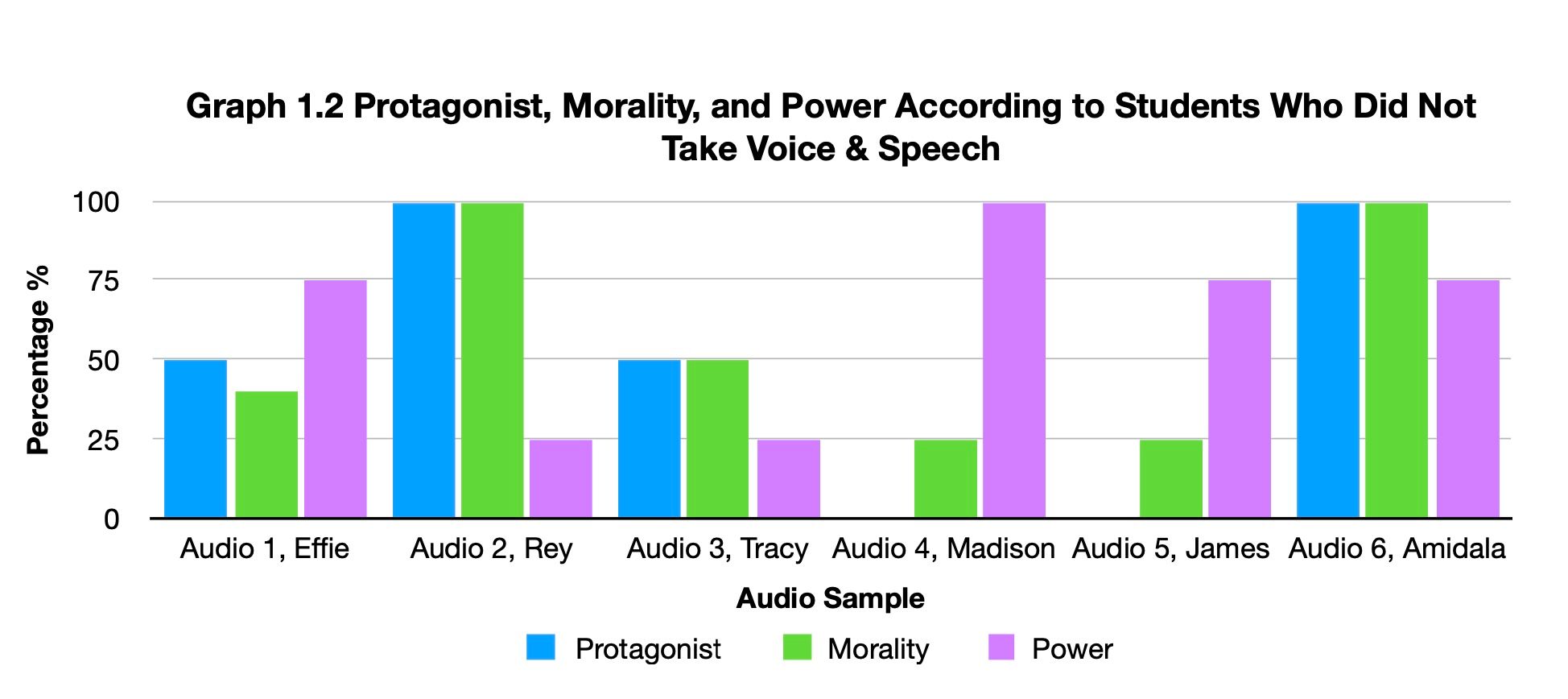
The above graphs (Graphs 1.1 and 1.2) present the percentage of listeners who answered “Yes” to whether or not the character was the protagonist, had a strong sense of morality, and wanted/desired power. We chose to isolate these traits because they indicate the character type. We expected protagonists (100% protagonist) to have high morality and low power desire and antagonists (0% protagonist) to have low morality and high power desire. We generally anticipated those with the transatlantic accent to be seen as upper class protagonists.
The answers are separated by those who have had Voice & Speech training (1.1) and those who haven’t (1.2) in order to determine whether or not that training had an impact on how the accent is received. Interestingly, both categories of students had the same responses for Audio 2, Rey and Audio 4, Madison who were the standard British and standard American controls. They were opposing as well, since Rey (BrE) was seen unanimously as a protagonist with strong morality, rarely desiring power while Madison (AmE) was unanimously seen as the antagonist, with little morality, but strong desire for power. This sets us up well as they are the conflicting parent accents of the transatlantic. But, ultimately, we don’t see any major distinctions between the responses from Voice & Speech students and non-Voice & Speech students.
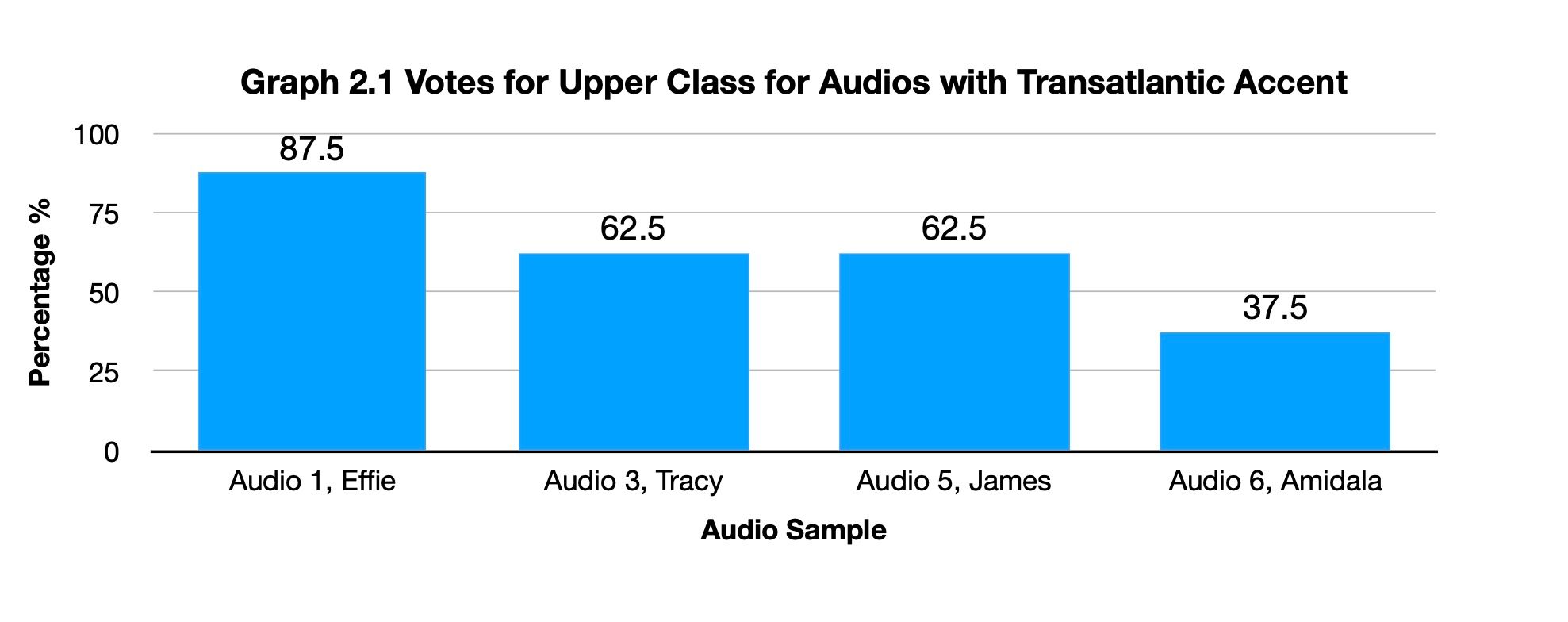
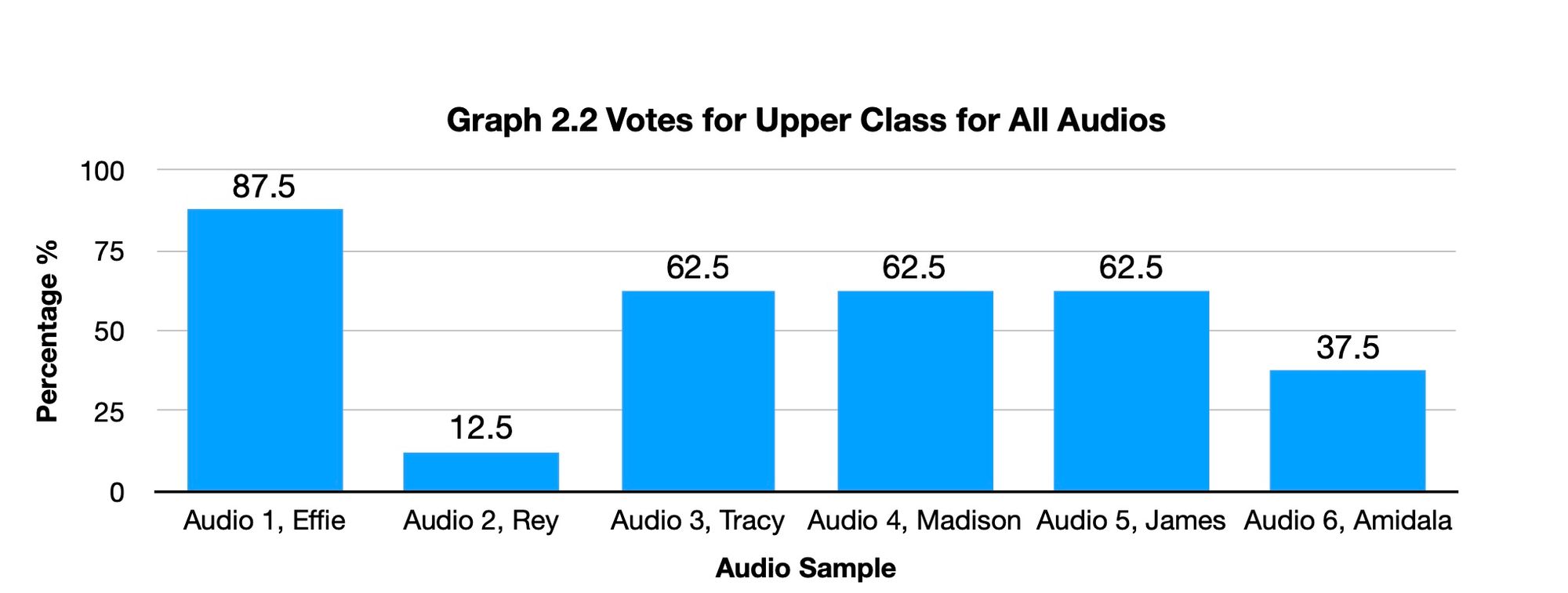
Audio Sample
Graphs 2.1 and 2.2 above depict the percentage of listeners that marked each character as “Upper Class” when asked about socioeconomic status. This sample was taken from both students who did and did not take Voice & Speech to get a picture of how all informants were responding to status implications. Graph 2.1 shows only the audios that use the transatlantic accent while Graph 2.2 shows all of the audios side by side, giving us a picture of the comparison. Two-thirds of the characters were predominantly seen as Upper Class, even Madison, who was our AmE control. It was surprising that Rey, our BrE control was seen as the least Upper Class since the standard British accent is typically received as posh and sophisticated. Interestingly, in the context of the whole film, Queen Amidala (Audio 6) only uses the transatlantic accent once she becomes Queen. Yet, our informants mostly saw her as middle class with the transatlantic accent. Effie is seen most often as high class, but almost all participants recognized her from the audio so they were likely influenced in their answers.
Discussion of Findings
As we conclude, it is important to note that because we chose audios from films we didn’t isolate the accent itself. As such, listeners were likely influenced by tone, content, vocabulary, syntax, and style when answering our questions. Although we spliced the clips to remove any context from the film, we couldn’t remove the filmic elements that would affect how the character’s language is received. In a future study, it would be beneficial to isolate the accent in order to narrow in on our desired variable.
Although we anticipated a greater contrast between the responses from Voice & Speech students and non-Voice & Speech students, we ended up getting similarly varied results. While we hoped Voice & Speech students would be more unanimous in their answering, we didn’t see a large enough difference since those who took Voice & Speech agreed unanimously eight times while those who didn’t agreed unanimously seven times. This difference of one seems too small to make any claims on. So, our two categories of informants may not be viewing the material as differently as we thought. In this case, perhaps the Voice & Speech training does not impact how listeners are viewing and thinking critically about the accent. Also, while many of the characters with the accent were marked as Upper Class, it wasn’t that different from the characters without the accent, and the percentages weren’t drastically high enough to make a claim about the accent pertaining to higher classes.
Notably, half of the participants who took Voice & Speech marked the audio as a protagonist when they didn’t know the character, suggesting that they do associate the accent with positive traits. Additionally, all but one Voice & Speech student answered “Yes” to the question of moral status when they didn’t know the character, further hinting that they associate the accent with positive, protagonistic traits. However, they were not consistent about socioeconomic status when they didn’t know the character, so we cannot make any claims in that regard. On the other hand, the non-Voice & Speech participants were more likely to mark an audio as being from pre-1980 if they didn’t know the character, indicating that they associate the accent with the earlier age of film while those with the training better understand its contemporary use as an attempt to mark status.
Further, with regard to the character’s region, all participants described the all characters with transatlantic accent as hailing from the “northeast” “Midwest” “New England” or “DC”. This completely dismisses the notion that the accent served “to rid English speakers of regionalization” (Dawson 15). Even though this type of speech was created to bridge the opposing sides of the Atlantic, the accent has become known for its Northeastern United Stats feel, even though it is not the dialect of that region. Thus, we cannot assume our stereotype of neutrality is applicable here. Though participants listed similar answers for the questions on occupation, we had several outliers with answers such as “trust fund baby” and “professional bitch” that, while amusing and perhaps signaling of status, did not seem like quantifiable data to go towards any larger conclusions.
Conclusions and Connection to Sociolinguistics
Ultimately, while we see some distinctions between the Voice & Speech respondents and the non-Voice & Speech respondents, it is difficult to come to any grand conclusion about how Voice & Speech training impacted their responses. We did however, reject the notion of neutrality with respect to region, since the audio clips were all marked as sounding from the East Coast. In terms of class, even though the accent was supposed to be neutral, Elliot argues that after 1970, it was “used only for extreme high status” (124). We did not see this reflected in our data, as even the characters who were from the upper class, did not have a high percentage of responses for Upper Class. Oddly, we got a lot of middle class responses for all of the characters. Yet, we still conclude that the accent is a marker of high class in some sense since that was the most popular answer for several audios. Yet, the accent still is not representative of any speaker. Mering argues that “This hybrid form of BrE and AmE fosters cultural pluralism” (5) and hopes that EFL speakers may benefit for more inclusion of the transatlantic accent in English learning as it allows for easier understanding of both English cultures. Although adoption of the accent could be “unifying” (Otero 41) in some sense, our mixed results remind us that this way of speaking is not the way any real person speaks—it is creating a false narrative of neutrality that is unnatural. Why should we value an accent as sophisticated when it does not actually represent anybody? Why don’t we hear what real people sound like in movies? What does that say about our cultural fantasies?
Further, because we did not see any major distinctions between the responses of those with Voice & Speech training and those without, perhaps we need larger discussions of Skinner’s harmful “Good American Speech” training and its negative impacts and associations. Allowing this education to be more widespread could help to find more neutrality in the accent. It could allow all consumers of film to question why we associate people’s speech with their class, especially when no class speaks that way in real life.
Notes on your exhibit for pop-up museum
For our pop-up museum, we will provide viewers with a miniature sample survey with Audio 3, James and Audio 6, Amidala along with all of the respective questions participants were asked (see appendix). We chose two of our audios with the transatlantic accent in order to highlight the sound for museum visitors and show them what the survey looked like for our informants. Since the original survey was much longer, we didn’t feel it necessary to include all of the examples and controls.
With our sample survey, we want to give them an opportunity to see what assumptions they themselves make in response to the audios and how the align (or don’t) with our participants. There are actually a few people in our class who have taken Voice & Speech so it will be exciting to see if they provide any interesting distinctions. It will also be great to have an open conversation about their reflections on their training and whether or not they feel like the view material like this differently now. Reflection was something we lacked in our survey, so it’s exciting to have the opportunity to do so.
With our presentation, we also want to open a discussion about the harm from Skinner’s “Good American Speech” with both actors and non-actors alike. We hope to share some ideas on the teaching itself and why it is fading in practice as well as how to understand about the contemporary use of the accent. We also aim to allow visitors to think critically about the way we associate accents with character traits, both positive and negative—especially when the accent in question does not represent any type of real person. Perhaps it’s a good thing to not be putting a population into a stereotype? But also, if these characters who use it are higher class, what does that say about cultural aspirations of status?
As we planned our museum exhibit, we debated whether or not to put one of our BrE/ AmE controls in the mix, but we figured we would only do the transatlantic accent from two very different characters to see how similar (or different) they are interpreted. Overall, we feel solid about how to present our research and look forward to more personal interactions with people as they take the survey, allowing for more open reflection and discussion.
Works Cited
Barrow, Janet. The Trans-Atlantic Accent: The Rise and Fall of a Hollywood Trend. ALTA Language Services, November 16, 2020. https://www.altalang.com/beyond-words/the- trans-atlantic-accent/
Dawson, Katherine. The Listening Cure: Theorizing Gender Fluid Performance Through Katharine Hepburn’s Transatlantic Accent. Oregon State University, Master of Arts, Department of English, 2020. https://ir.library.oregonstate.edu/downloads/70795g06m? locale=en
Elliot, Nancy C. “Peer-reviewed Article Rhoticity in the Accents of American Film Actors: A Sociolinguistic Study.” Voice and Speech Review, vol. 1, no.1, 2013, pp. 103-130. https:// doi.org/10.1080/23268263.2000.10761390.
Law, Hannah. Acting With An Accent: A Practical Exploration of General American Accent vs British Received Pronunciation Via International Phonetic Alphabet Applied To Performance. Texas Christian University, Department of Theatre, May 5, 2014. https:// repository.tcu.edu/bitstream/handle/116099117/7245/Law__Hannah_-_Final_Thesis.pdf? sequence=1
Mering, Andy. Mid-Atlantic English in the EFL Context: A Large-Scale Sociolinguistic Study. Nomos Verlagsgesellschaft, Baden-Baden, Germany, February, 2022. Accessed via https://books.google.com/books? hl=en&lr=&id=CKhgEAAAQBAJ&oi=fnd&pg=PR5&dq=midatlantic+English+in+the+ EFL+&ots=MA77LJJs7i&sig=LCkPmb_8Sp5aEFJNmpOaSJPqCKY#v=onepage&q&f= true
Appendix
Sample survey here: https://wss.pollfish.com/link/5a07f566-0fed-49f2-9fff-093d339c377d
By: Koko Waller & Stephen Ropski


